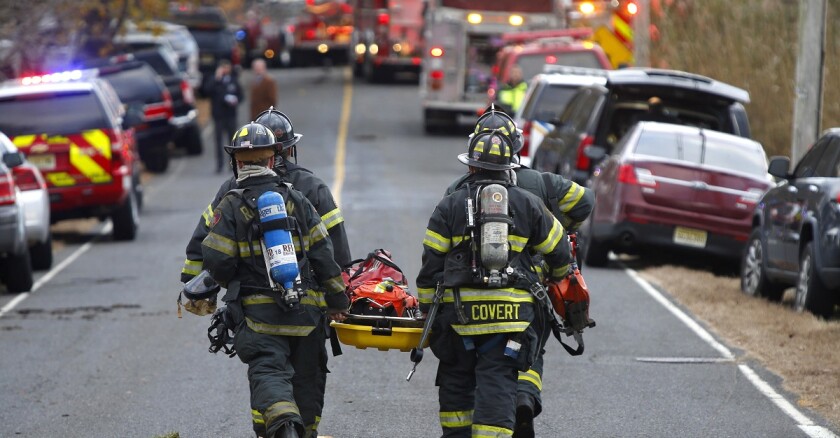“Volunteers are not easy to get,” he says. “And they’re difficult to retain. The baby boomers are aging out, and the newer generation doesn’t have that sticking power that the generations did before.”
In the last two years, the number of volunteer firefighters in North Carolina dropped by about 1,200 -- a roughly 22 percent decline, according to the Federal Emergency Management Agency (FEMA).
Like other fire chiefs in the state, Cash is constantly recruiting volunteers. He runs a junior firefighter program that taps students as young as 14 to help with nonhazardous tasks. More recently, he's been trying to figure out how to encourage more women and minorities to join a field that's historically been dominated by white males.
North Carolina is not alone. Many states face similar shortages.
In Pennsylvania, where Benjamin Franklin started the nation's first volunteer fire company in 1736, the number of volunteer firefighters declined from 300,000 in the 1970s to 38,000 in 2018, according to the Pennsylvania Fire and Emergency Services Institute.
The loss has already forced some departments to reduce their services, diminishing the effectiveness of their emergency response.
“There are fire companies shutting down all over the state,” says Pennsylvania state Rep. Steve Barrar, co-chair of the legislature’s emergency preparedness committee. “This is not just a statewide crisis. This is a national crisis."
While the nationwide number of firefighters -- volunteers and paid -- has declined 5 percent since the 1980s, the number of paid firefighters has increased 65 percent. Without enough volunteers, departments have had to hire more paid staff.
The shift is expensive. A Pennsylvania Fire and Emergency Services Institute study estimated last year that the value of volunteer firefighters could be as high as $10 billion a year. With the continuing loss of volunteers, "taxpayers will face a very steep price tag," the report warns.
"I truly believe that if we lose our volunteer system it will mean higher property taxes to every community in the state of Pennsylvania," says Barrar.
Why Doesn't Anyone Want to Be a Volunteer Firefighter?
There are multiple reasons for the decline.
These days, fire departments handle far more medical calls than fires, and that doesn't fit the image that lures some people to volunteer. When responding to a fire, there's an adrenaline rush, says Cash. "When an elderly lady falls, it's not quite as exciting."
Furthermore, the requirements to become a volunteer firefighter have grown and require a major training commitment.
Small communities are more dependent on volunteers than bigger cities. Over the past couple generations, they've also been losing people -- and volunteers -- to those larger urban areas.
Cherryville, for example, was the home of 11 textile plants and a large trucking company 25 years ago. Those businesses are now gone.
“People lost their jobs, and many now commute to Charlotte. That’s nearly 40 miles away,” says Cash. “So many families commute, and they have to take care of their kids and go to Little League, and they just don’t have time for community service.”
Expanding the Benefits and Recruitment Pool
How can fire departments fill the gap?
A commission of fire and emergency service organizations in Pennsylvania recommended a few solutions for the state: better online marketing, increased incentives, and more funding for training and equipment. The boots, helmet and fire suit run as high as $4,000 -- some of which is often paid for by the volunteers themselves.
Montgomery County, Md., is proof that those solutions might work. The number of volunteer firefighters there has remained steady for a decade.
The county uses grants and state aid to cover volunteers' equipment and training costs, and offers a monthly retirement payout ranging from $250 to $370 to volunteers who serve for 25 years. The recruitment effort is also aided by a $6,500 state income tax credit for volunteer firefighters.
But these kinds of incentives are only part of the answer, says Eric Bernard, executive director of the Montgomery County Volunteer Fire Rescue Association.
Good management of the volunteer experience is crucial, he says. The county has also focused on creating a welcoming environment for minorities and women. The volunteer trainer for the county’s basic orientation course, for example, is a woman of Guatemalan and French descent who speaks Spanish, French and Portuguese.
Of the volunteers recruited in the last nine years, half are women and half are minorities. In the past, “it was young white males and older white males," says Bernard, "but we’re changing.”
Bernard, like Cash, is recruiting all the time -- when he goes to the supermarket, at lunch, in libraries, high schools, churches and synagogues.
“Every volunteer department is looking for the magic bullet, but there is no magic bullet,” he says. “It’s constant work. You can never stop.”
This appears in the Management newsletter. Subscribe for free.









